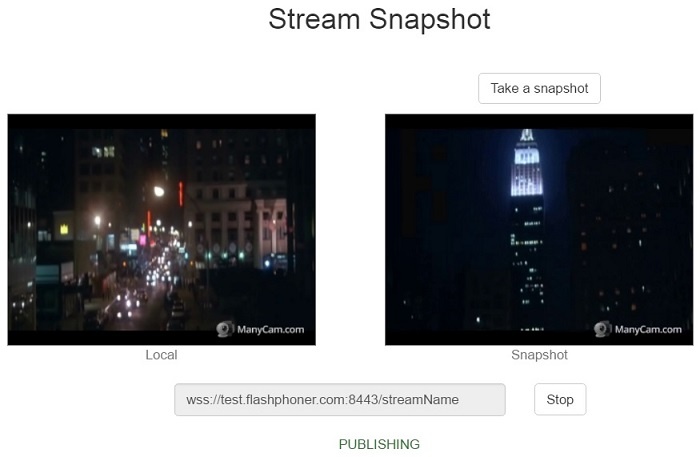Example demonstrating how to take snapshot of a published stream
This example demonstrates taking snapshot of a stream published on Web Call Server.
On the screenshot below a snapshot of the stream being published has been taken.
When publishing is started, video from the camera is played in 'Local' element on the left side of the page.
When 'Take a snapshot' button is clicked, snapshot is taken and displayed in 'Snapshot' element on the right side of the page.
Code of the example
The path to the source code of the example on WCS server is:
/usr/local/FlashphonerWebCallServer/client/examples/demo/streaming/stream-snapshot
stream-snapshot.css - file with styles
stream-snapshot.html - page of the example
stream-snapshot.js - script providing functionality for the example
This example can be tested using the following address:
https://host:8888/client/examples/demo/streaming/stream-snapshot/stream-snapshot.html
Here host is the address of the WCS server.
Work with code of the streamer
To analyze the code, let's take the version of file stream-snapshot.js with hash 6f0eb5fa1576abc0e4008d52768af56977c7ed61, which is available here and can be downloaded with corresponding build 0.5.15.1977.
1. Initialization of the API. line 13
API is initialized after loading the page. For Flash support, the path to SWF file is passed to the init() method.
Flashphoner.init({flashMediaProviderSwfLocation: '../../../../media-provider.swf'});
2. Connection to server. line 76
Connection to server is established when Start button is clicked.
Flashphoner.createSession({urlServer: url}).on(SESSION_STATUS.ESTABLISHED, function(session){
//session connected, start streaming
startStreaming(session);
}).on(SESSION_STATUS.DISCONNECTED, function(){
setStatus(SESSION_STATUS.DISCONNECTED);
$('#url').prop('disabled', false);
onUnpublished();
}).on(SESSION_STATUS.FAILED, function(){
setStatus(SESSION_STATUS.FAILED);
$('#url').prop('disabled', false);
onUnpublished();
});
Session is created with method createSession(). Callback function, which will be called in case of successfully established connection (status SESSION_STATUS.ESTABLISHED), is added.
3. Video streaming. line 93
After establishing connection to the server, new video stream is created with method session.createStream(), and function publish() is called to publish the stream.
When stream is created, the following parameters are passed
- streamName - name of the stream
- localVideo - <div> element, in which video from camera will be displayed
session.createStream({
name: streamName,
display: localVideo,
cacheLocalResources: true,
receiveVideo: false,
receiveAudio: false
}).on(STREAM_STATUS.PUBLISHING, function(publishStream){
setStatus(STREAM_STATUS.PUBLISHING);
onPublishing(publishStream);
}).on(STREAM_STATUS.UNPUBLISHED, function(){
setStatus(STREAM_STATUS.UNPUBLISHED);
//enable start button
onUnpublished();
}).on(STREAM_STATUS.FAILED, function(){
setStatus(STREAM_STATUS.FAILED);
//enable start button
onUnpublished();
}).publish();
When stream is created, callback functions for events STREAM_STATUS.PUBLISHING, STREAM_STATUS.UNPUBLISHED, STREAM_STATUS.FAILED can be added.
STREAM_STATUS.PUBLISHING - when this status is received, function onPublishing() of the example is called to make appropriate changes in controls of the interface.
STREAM_STATUS.UNPUBLISHED and STREAM_STATUS.FAILED - when one of these statuses is received, function onUnpublished() of the example is called to make appropriate changes in controls of the interface.
4. Taking snapshot. line 31
New stream object is created when 'Take a snapshot' button is clicked.
Name of the published stream is passed to method session.createStream() when the new stream is created, and method snapshot() is called to take snapshot of the stream.
session.createStream({name: name}).on(STREAM_STATUS.SNAPSHOT_COMPLETE, function(stream){
console.log("Snapshot complete");
setSnapshotStatus(STREAM_STATUS.SNAPSHOT_COMPLETE);
snapshotImg.src = "data:image/png;base64,"+stream.getInfo();
//remove failed callback
stream.on(STREAM_STATUS.FAILED, function(){});
//release stream object
stream.stop();
}).on(STREAM_STATUS.FAILED, function(stream){
setSnapshotStatus(STREAM_STATUS.FAILED);
console.log("Snapshot failed, info: " + stream.getInfo());
}).snapshot();
Callback function, which will be called when snapshot is taken (status STREAM_STATUS.SNAPSHOT_COMPLETE), is added to display the snapshot image.
5. Releasing snapshot stream object. line 38
The following method is called to release the stream object in case of failure
stream.stop();
6. Stop of streaming. line 48
The following method is called to stop video streaming
stream.stop();
After calling the method, status STREAM_STATUS.UNPUBLISHED should arrive to confirm stop of streaming from the server side.
